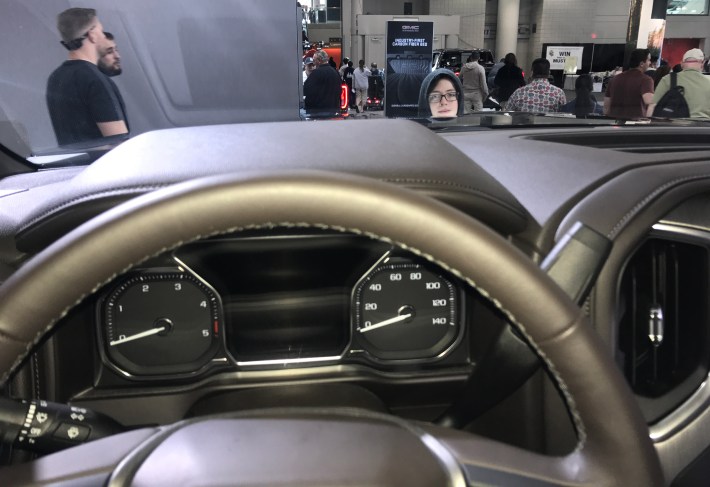The city Department of Transportation, responding to a wave of cyclist and pedestrian deaths caused by the drivers of SUVs and light trucks, now says it will "begin to track" the vehicles involved in fatal crashes to better evaluate the killing power of the increasingly popular assault cars.
It's the first time the DOT will examine the role that specific vehicles play in contributing to death from crashes — which are up by double-digit percentages this year.
"Recent news reports have cited SUVs’ role in increases in pedestrian and cyclist fatalities, a trend that Commissioner Trottenberg has publicly cited as among the likely causes of this year’s fatality increases within New York City," the agency said in a statement. “As a result, DOT will now begin to track its fatal crash data more granularly. By the end of this year, we will be able to provide by year the comparative numbers of fatal collisions where SUVs were involved.”
City agencies have thus far not tracked the killing power of specific vehicles — but it's long overdue. The DOT response comes days after the federal government released new evidence that the so-called "light trucks" have played an outsized role in the ongoing epidemic of death on our nation's streets — even as the vehicles get safer for their occupants.
In 2008, for example, SUV occupants had a death rate of about 10.4 per 100,000 vehicles, federal data show in table 2 here. By 2017, that rate had fallen 33 percent to 6.9 deaths per 100,000 vehicles. The same table shows that there are more than 66 million SUVs on the road now, up 64 percent from a decade ago.

And that rise has unleashed a torrent of blood on American streets: SUVs and other light trucks accounted for 45 percent of the cyclists and 41 percent of all the pedestrians killed last year, according to federal stats. The death rate associated with SUVs specifically is rising most dramatically, up 20 percent for cyclists since 2009 and 23 percent for pedestrians. The cars are simply bigger and designed to protect their occupants first and foremost.
Those figures are not known for New York City, which is why the DOT says it will examine the data more closely. Neither the city nor state health departments track such data, though many localities, including San Francisco and Chicago, currently employ epidemiologists to see traffic violence through a health prism — and treat it like the preventable epidemic it is.
Safety experts have been calling for the health approach for years.
"If 30,000 people were killed each year in the United States by a curable illness, we would call it a public health crisis. We would deploy resources, vaccines and interventions to address the spread and bring the death toll to the only acceptable level: zero," the Vision Zero Network said in a 2016 report. "Yet, every year 30,000+ people are killed in preventable traffic collisions in this country. Vision Zero asks us to see those traffic deaths like polio or cholera: epidemics that, with an urgent health framing and public response, can be eradicated."
More recently, Mary Beth Kelly of Families for Safe Streets has been calling on state health authorities to declare this year's increase in all city road deaths a "public health emergency," which would give city officials emergency powers to solve the problem — much as the de Blasio administration did after declaring making an emergency declaration earlier this year during a small measles outbreak.
"These crashes are too frequent, too predictable, too deadly, and, most importantly, preventable!" she recently told a group of medical students at a forum named after her husband, Dr. Carl Nacht, who was killed by a driver. "We have the anti-virus — [and] this epidemic, and like any other, requires cultural and systemic intervention. ... But we lack the political will to change a culture dominated by cars and speed. And need our health community! We need you in this struggle to save lives and eliminate the intense and widespread suffering that this scourge inflicts on our families and our communities."
"Where are our Departments of Public Health?" she asked.
Neither State Health Commissioner Howard Zucker nor city Health Commissioner Dr. Oxiris Barbot agreed to take questions from Streetsblog.

But the DOT is getting credit for its epidemiological look at the SUV crisis.
"Seeing the crisis through the public health lens, will help us see the danger of bigger trucks, for example," said Transportation Alternatives' Executive Director Danny Harris.
That said, New York is extremely late to the party when it comes to assessing traffic violence as a health problem rather than a transportation problem. London, for example, doesn't merely seek to create "safe streets," but mandates the notion of "healthy streets." Under the "Healthy Streets for London" program started by Mayor Sadiq Khan in 2016 [PDF], roadways are not merely designed for safety for cyclists and drivers, but also to make sure pedestrians are safe from crashes, from anxiety, from noise or even from being discouraged from walking at all.
That public health lens has helped reduce fatalities, which are dramatically lower than New York this year, even though greater London has a half-million more people.
"A public health approach creates different layers for how we design streets," Andy Summers, transport strategy and planning manager [sustainable modes] for Transport for London, told Streetsblog. "We use [crash statistics], of course, but we also look at physical activity data to see where people are inactive or active. And we look at noise. Those are new data layers that we use when designing streets."
Summers thinks that the NYC DOT's look at SUVs could be only the beginning, depending on how the data is used. In London, for example, the citizenry's basic health became the measure of whether streets were designed properly.
"The goal of the street is to encourage active transport," he said. "The key tool has been the 'healthy streets checklist.' It has 10 indicators of how transport schemes could improve physical activity and health. Those attributes came through health research. It's how you use evidence. We use it whenever we design streets."
It's working: Between Jan. 1 and Oct. 21, London had a total of 103 road fatalities — 76 fewer deaths (78 percent less) than New York, which has a smaller population.
To break that down, in London, there have been 60 pedestrian deaths (48 percent fewer than New York), 29 cyclist and motorcyclist deaths (69 percent fewer than New York) and 14 driver deaths (193 percent fewer than New York). The population of greater London is about 7 percent higher than New York City.
And even when New York City was having its safest year on record last year, with just 203 total deaths, London was still a far safer city.
In 2018, London registered just 112 road deaths, 81 percent fewer than less-populous New York.
The death rate in London that year was 1/79,464 residents, compared to New York's death rate of 1/40,886 residents — or nearly twice as deadly as the British capital.
And SUVs don't only cause immediate death — they also kill city residents a little bit each day.
New York City officials have done nothing about this, but in April, London created an "ultra-low emissions zone" in the city's central business district that forces the drivers of high-pollution vehicles to pay a fee to enter the zone. As a result, far fewer drivers now enter that area — and toxic pollution is down 30 percent, according to local reports.
Roadside nitrogen dioxide pollution has reduced by one third in the #ULEZ zone since we launched it six months ago - a huge improvement as we work to clean up toxic air and protect our children’s lungs. #LetLondonBreathe#DeliveringChangeForLondonhttps://t.co/duRRHa4wDL
— Sadiq Khan (@SadiqKhan) October 21, 2019
It's not as if New York City's Department of Health and Mental Health has done nothing as part of the city's Vision Zero initiative. It's just unclear what that is. Streetsblog asked the agency for full details of the department's role in Vision Zero and got back this:
The Dept of Health has a dedicated analyst looking at public health data retrospectively [with the title] Senior Traffic Safety Specialist. The person is within the Department of Health’s Injury and Violence Prevention Program. We have additional analysts who support the work.
The Department of Health and Mental Hygiene’s Injury and Violence and Prevention Program (IVPP) is the agency’s liaison to the Vision Zero Task Force, as such, we do the following:
Health leads on liaising with different agencies to map out the research agenda. For example, DOHMH, in consultation and organization with the VZ Data Working Group, spearheaded the implementation of Research on the Road, an event where external researchers are invited to collaborate and encourage studies that address traffic safety issues in NYC. We look for unanswered questions as well as what additional data we need to make Vision Zero successful. This includes injury indicators as well as surveillance data on physical activity and other figures that may be relevant to Vision Zero. IVPP also serves the role of keeping our internal colleagues updated on all VZ initiatives. As part of our regular day-to-day, the Department of Health carries out the Community Health Survey on a range of health topics, with a small, but critical representation of traffic safety questions where we can link partner agencies like DOT to that data.
It's unclear what any of that means, specifically, and the agency declined to answer follow-up questions. Streetsblog was hoping for more information, including the name of the senior traffic safety specialist and the results of his or her "research agenda." The agency declined to make that person available for interviews.
For its part, a spokesman for the state Department of Health offered only an aspirin for the public health emergency.
“Traffic injuries and fatalities are a major public health concern that the Department takes very seriously," said spokesman Jonah Bruno. "We have met with street-safety advocates to listen to their ideas. We look forward to continuing our dialogue and finding ways for cyclists, pedestrians and motor vehicles to share the road safely.”






